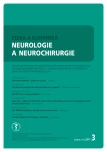Fetal Radiation Risk Due to X-ray Procedures Performed on Pregnant Women
Authors:
L. Súkupová 1; P. Vachata 2
Authors place of work:
Úsek ředitele, Institut klinické
a experimentální medicíny, Praha
1; Neurochirurgická klinika UJEP
a Krajská zdravotní a. s.
Masarykova nemocnice v Ústí
nad Labem, o. z.
2
Published in the journal:
Cesk Slov Neurol N 2017; 80/113(3): 276-279
Category:
Přehledný referát
doi:
https://doi.org/10.14735/amcsnn2017276
Summary
The paper provides a review of information regarding fetal doses and subsequent detrimental effects from X-ray procedures performed on pregnant patients. Fetal doses from X-ray procedures performed outside the abdomen and pelvic area are negligible and there is no reason for concern. Fetal doses from radiography of the abdomen and/or pelvic area can be as high as several mSv and, therefore, still far away from a threshold for detrimental effects. Fetal doses from CT, fluoroscopy and interventional procedures in the abdomen and/or pelvic area can exceed the threshold of 100 mSv for detrimental effects. It is necessary to make an accurate estimate of the fetal dose based on exposure parameters and used projections. If the estimated fetal dose is higher than 500 mSv, some detrimental effects will appear. If the estimated fetal dose is in the range of 100–500 mSv, the phase of the pregnancy as well as other aspects (ethical, religious...) need to be considered before making any decision. An estimated fetal dose lower than 100 mSv does not represent any risk of detrimental effects for the fetus.
Key words:
fetal dose – X-ray procedure – detrimental effects – stochastic effects
The authors declare they have no potential conflicts of interest concerning drugs, products, or services used in the study.
The Editorial Board declares that the manuscript met the ICMJE “uniform requirements” for biomedical papers.
Štítky
Dětská neurologie Neurochirurgie NeurologieČlánek vyšel v časopise
Česká a slovenská neurologie a neurochirurgie

2017 Číslo 3
- Metamizol jako analgetikum první volby: kdy, pro koho, jak a proč?
- Cenobamát snižuje frekvenci záchvatů a polymedikaci u farmakorezistentní epilepsie s větším přínosem v časnějších liniích léčby
- Nejčastější nežádoucí účinky venlafaxinu během terapie odeznívají
- Zolpidem může mít širší spektrum účinků, než jsme se doposud domnívali, a mnohdy i překvapivé
Nejčtenější v tomto čísle
- Myotonická dystrofie – jednota v různosti
- Riziko poškození plodu v důsledku rentgenových výkonů u gravidních žen
- Vertebrogenní algický syndrom – medicína založená na důkazech a běžná klinická praxe. Existuje důvod něco změnit?
- Febrilní křeče – méně je někdy více
